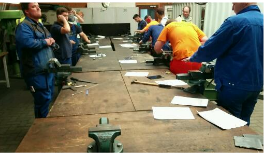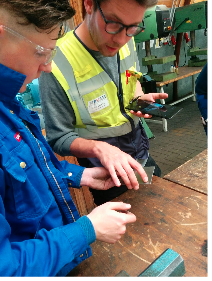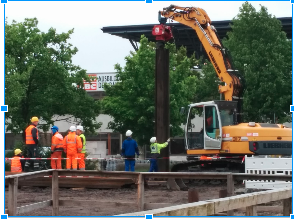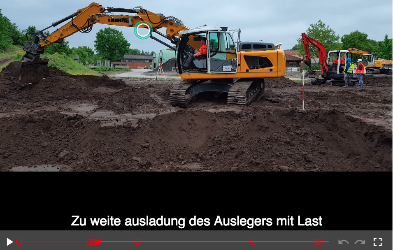Pilot Testing the AchSo Tool with Bau-ABC Apprentices
Main impacts
- Enabled contextual on-site learning and passing on of knowledge from experienced workers
- Motivated apprentices to create learning materials themselves
The situation before Layers
Highlights
Apprentices being trained in Bau-ABC Rostrup are used to request help from the trainer face to face. However, the trainers are not always available for face-to-face talks due to simultaneous requests from several apprentices or other issues to be solved on the premises of the training centre. In addition, in some cases the apprentices might be too shy to ask for help. As a result, help and feedback are not always received when needed. This means that when the trainer is not available, learning takes place through trial and error, and as the apprentices have no time to leave their construction sites in Bau-ABC to take notes or document their experience, the take-up of a learning situation is often rudimentary.
Description
Bau-ABC Rostrup (hereinafter “Bau-ABC”) is a so-called intermediate training centre of construction industry and part of the German dual vocational education and training (VET) system. Such centres serve as venues for workplace training in a safer and richer environment than ordinary construction sites, where their engagement is dependent on ongoing construction projects. Learning process in Bau-ABC is fully hands-on: groups of apprentices work on practical projects - building walls, laying asphalt, boring wells and similar - under the supervision of trainers. At the beginning of apprenticeship the communication between trainers and apprentices is higher and decreases as the apprentices gain more the experience and skill. Trainers mostly provide basic information for a project, and are sometimes not available for face-to-face talks.
We get paper what has to do be done. But without information how to do it”, and “There is no how. As an example, we get a document on digging a pit. It doesn’t say how to exactly do that and what do we have to be careful about but only that it needs to be 1,20m deep…do it!
Apprentice in Bau-ABC Rostrup, 2016
When help is needed, apprentices request it from the trainer face-to-face. However, they may not receive help or feedback immediately, e.g. when the trainer is busy with other apprentices/ other tasks on the premises, or when the apprentice is too shy to ask for help (especially when asking the same thing for the second time). In these situations, facing a new learning situation is characterized by trial and error. When apprentices stumble over a problem, the take-up of a learning is often rudimentary, as they do not have time to leave training centre’s construction site to take notes and write down experiences in the White Folder (a bulky folder where apprentices gather paper-based project documentation).
A video annotation tool such as AchSo was seen as one possible solution in the situations where more intensive communication both from the apprentice as well as the trainer is needed but circumstances do not allow for enough face-to-face communication.
Initially, AchSo had been piloted as a standalone tool by the Aalto University researchers in Finnish vocational education context (see Renewing practices of vocational education and training for construction sector in Finland). In Germany AchSo had been available via another Layers toolset, Learning Toolbox (see Use of Learning Toolbox (LTB) by Bau-ABC Trainers and Apprentices). However, it required a separate login and had thus found limited use. Therefore, a specific introductory event was organised in Bau-ABC to introduce AchSo as a standalone tool in selected trades.
What Layers did
Highlights
The pilot testing of AchSo with Bau-ABC Rostrup was organised by team members from Aalto being in charge of the presentations and instructions and team members from ITB and UIBK supporting them and collecting feedback. During the three-day field visit AchSo was presented to two groups of apprentices - well-builders and (construction) plant operators. The testing with well-builders took place in the workshop for metalworking, whilst the testing with the construction plant operators place in outdoor areas. Feedback was gathered from the apprentices and trainers during the three-day kick-off as well as several months later.
Description
During the three-day field visit AchSo was presented to two groups of apprentices - well-builders and plant operators. The former group had been using the Learning Toolbox, the latter group not. The presentation of the tool was led by researchers from Aalto University (Finland) who were in charge of the tool development and had piloted the tool with construction industry and vocational schools in Finland.
The well-builders (Brunnenbau) used AchSo while having a one-week course in metalworking.
First, the researchers from Aalto gave the background information on AchSo and how it works. They also clarified issues around data protection, privacy and sharing.
After that, the Bau-ABC Rostrup trainers introduced the task – cutting a metal plate to a measure, filing the edges and marking spots at given distances for further processing.


Figures 1 and 2: Apprentices starting their projects in metalworking and presenting videos on their work to the trainer
After the introduction the apprentices started working with the task and shooting videos of each other’s work at different phases. One of the trainers also shot some videos on the work of apprentices. Some apprentices shot only one video, while others tried to cover all major phases of work with short video clips. At the end of the day the videos were shown as a gallery and some exemplary videos were played.
In the group of plant operators, the apprentices did test videos, annotated and uploaded them. The apprentices formed their own groups since they were used to performing their tasks in groups of four to six people. The tasks included for example using excavators and installing sheet piling into the ground. The apprentices worked outside and the groups were spread apart from each other.
!
Figure 3: Construction vehicle drivers (Baugeräteführer) starting their training
Most of the apprentices used their own devices, only the Samsung phones brought by the researchers were taken along. Topics of the videos included checking up of an excavator before work, common safety issues when excavating, work descriptions, oiling the joints of the excavator and similar.

Figure 4: An apprentice comments a health and safety risk with his annotation on an AchSo video: “The load is too far and the excavator is unbalanced”.
The situation after Layers
Highlights
The construction companies’ low tolerance or scepticism towards mobile devices at workplace hindered the active usage of AchSo after the kick-off. Nevertheless, the feedback collected during the field visits some months later showed that AchSo was occasionally used by apprentices in their companies and during their time at Bau-ABC. As a key finding, AchSo supports immediate learning from work through facilitated experiencing and helps to reduce spatial, temporal, social and contextual barriers to learning (in particular as an integral part of the Learning Toolbox).
Description
We found that AchSo helps to (a) facilitate experiencing and (b) overcome barriers for informal learning.
Regarding (a), AchSo enables immediate learning during an experience and, the take up of learning experiences. Apprentices highlighted the value of rich contextual descriptions and visualisation of problems and solutions with AchSo. AchSo enables to “save” a learning experience by making a video on a problem, annotating it, and send it to others, asking them about their opinion on how to solve the problem.
It is better to watch how a problem was solved that I face instead of just reading a text […] you can better envisage what is really meant.
Apprentice in Bau-ABC Rostrup, 2016
You can better understand, you know what you need for solving a problem, watching an annotated video provides you with the necessary details.
Apprentice in Bau-ABC Rostrup, 2016
We [as apprentices] did videos already and when the new apprentices would have a look in AchSo they would see our videos and could directly learn something. They would see what we did, where our problems were.
Apprentice in Bau-ABC Rostrup, 2016
Regarding (b), AchSo helps to overcome barriers for learning, e.g. situations where geographic distance (spatial), time lag between occurrence of a problem and possibility to ask help (temporal), social awkwardness (social) or lack of context knowledge (contextual) hinder knowledge sharing.
As to overcoming spatial and temporal barriers, the apprentices found that by using AchSo, they can ask the trainer for help even he is in a different location and to reduce the time lag between the occurrence of the problem and the possibility to ask for a solution.
Sometimes it is better to use the tool instead of looking after a LWM [trainer] who you would not find anyway.
Apprentice in Bau-ABC Rostrup, 2016
As to social barriers, AchSo can support apprentices to overcome their fear of asking the LWM or their peers face-to-face for another explanation.
If I am afraid to mention that I did not understand something I can simply watch a video to learn more about it.
Apprentice in Bau-ABC Rostrup, 2016
As to contextual barriers, the lack of overview on the working context makes it difficult for young workers to transfer their learning into appropriate practice.
It is definitely nicer to have a video instead of simple text saying what to do. You can better imagine what happens. The video and the comments attached to it help us to understand the situation. E.g. what is the reason that the digger shifts around if I do this and that.
Apprentice in Bau-ABC Rostrup, 2016
Although testing AchSo was not fully integrated into the deployment of Learning Toolbox (see Use of Learning Toolbox by Bau-ABC Trainers and Apprentices), some trainers and apprentices saw the potential of AchSo as a part of Learning Toolbox toolset as mutually complementing tools.
Impact that Layers created
Changed learning practices
AchSo helped the apprentices to learn more from experiences made while working (by making videos and annotating important moments/elements), share and discuss these experiences with others (see Report of Summative Evaluation in the Construction Pilots, [1])
Improved the creation and use of learning resources
AchSo videos were seen as means by which experienced workers/other apprentices could share their knowledge to apprentices despite of spatial, temporal, contextual and social barriers.
In addition, the apprentices themselves create learning resources instead of earlier mostly one-way flow of information in form of instructions from trainer or supervisor.
Links to other sections
- Tools
- Impact cards
- Learning scenarios
Further Reading
Virnes, M., Thiele, J., Manhart, M. (2016). Working paper: Applying mobile learning to vocational training at construction sites: barriers and possibilities.
Contributing Authors
Pekka Kämäräinen, Markus Manhart, Sanna Reponen, Rainer Schütte (Bau-ABC), Sascha Wiechmann (Bau-ABC), Jaanika Hirv
References
- V. Banken, M. Geiger, R. Maier, M. Manhart, C. Sarigianni, S. Thalmann, and J. Thiele, “Report of Summative Evaluation in the Construction Pilots,” pp. under review, 2016 [Online]. Available at: Link
